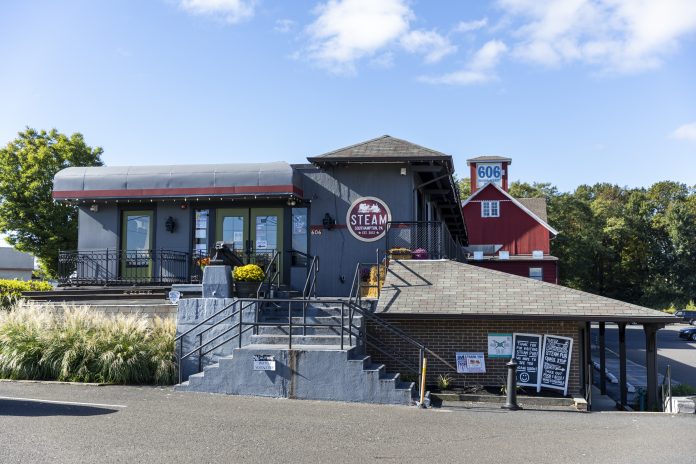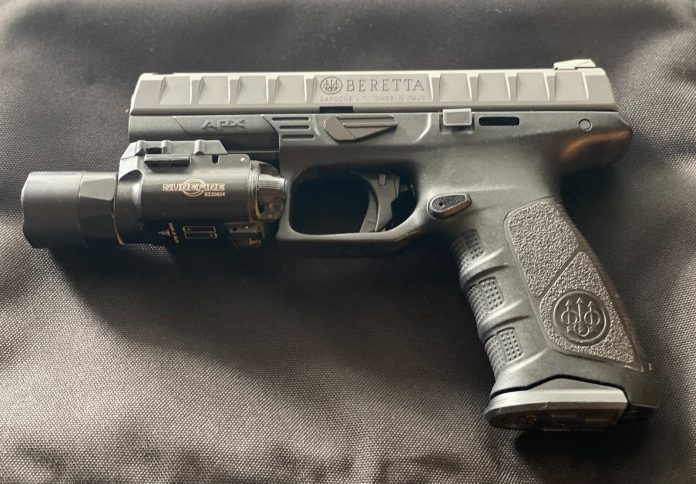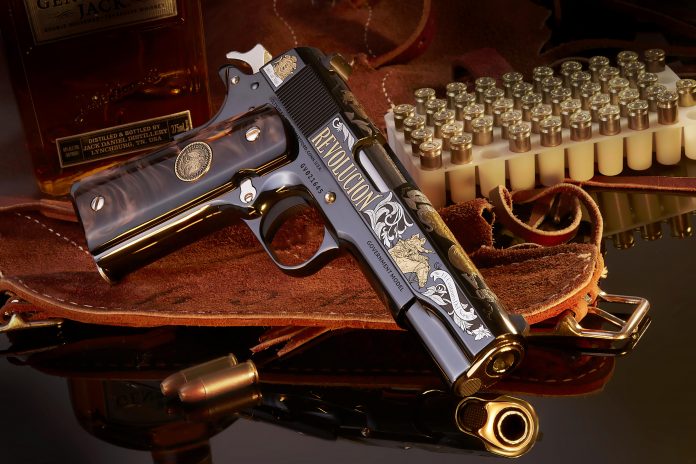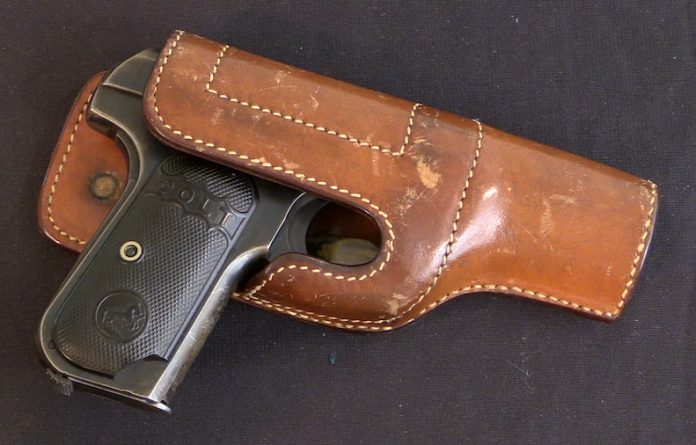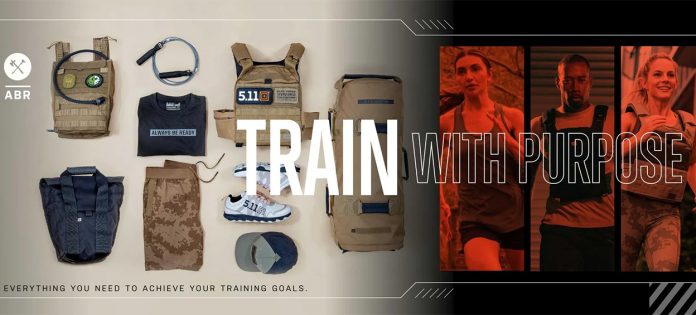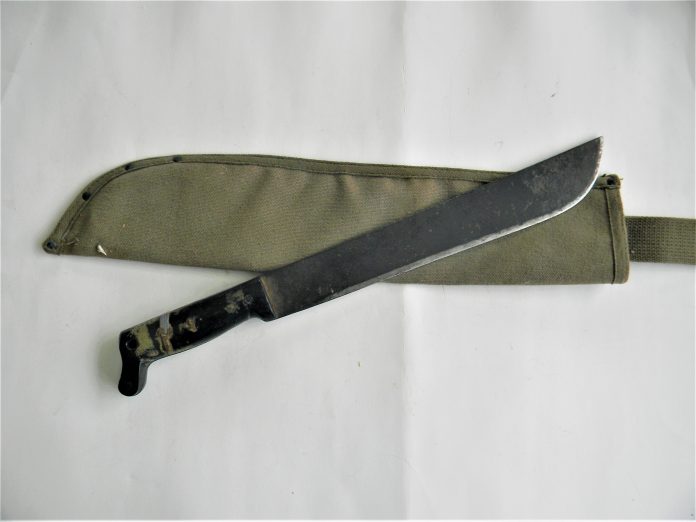4v1 fights generally don’t end well for the victim. Even with a high degree of martial arts proficiency, fighting four people is still long odds. Thankfully, armed self defense is legal in much of America. With the expenditure of some money and free time, an individual armed with a handgun, and a modicum of training can level the playing field, even against long odds. For a 5’6″ 140lb man like Liam Hughes that’s exactly what happened when he and a friend exited a bar in Southampton Twp. Pennsylvania late Friday night.
Despite multiple head wounds, including a split lip and a concussion, Hughes fought through two successful attempts to drag him from his vehicle and beat him to the ground. On the third, he managed to lunge inside his vehicle to reach the handgun he had concealed inside. Dragged from the vehicle, he found himself on the ground again, multiple attackers looming directly over him. undeterred by Liam shouting that he had a gun, they advanced a final time. Armed self defense made the difference.
After being beaten repeatedly by numerous, larger assailants who seemed unbothered by the fact that their victim was armed, Hughes finally resorted to lethal force, discharging 8 shots, killing two of his attackers and hitting a 3rd in the arm before recognizing that the threat had ended and the two remaining attackers had fled. Hughes ceased fire, and almost immediately called 911.
In a press conference, the District Attorney cited Hughes’ attempts to defuse the situation, announce his armed status prior to resorting to self defense, and generally calm, cooperative behavior with both the dispatcher and police as causal factors in his decision not to charge him. The video of the incident is available here, and is unfortunate testimony to the fact that, while violent assaults are not commonplace, armed self defense is the best method of surviving pulling that short straw.
Armed Self Defense Works
The Colt M1903 and M1908 Pocket Hammerless – An Unlikely Duty Gun
When I say duty pistol, you probably picture something like the 1911, the Glock 17, or the Beretta 92 series. You likely don’t picture the Colt M1903 or M1908 Pocket Hammerless pistols. However, you might be surprised how often these handguns popped up as a duty pistols. Why are these odd choices for a duty pistol?
First is the calibers. The Colt M1903 is a .32 ACP pistol, and the M1908 is a .380 ACP. These two calibers are most commonly known for their role in pocket pistols. Speaking of pockets, the name Pocket Hammerless is also a good clue as to what the pistol was intended for. Browning designed the pistols to be low profile and easy to carry concealed, not as duty pistols. Although it’s not truly hammerless, the Colts feature a shrouded hammer.
At the end of the day, John Browning didn’t design the M1903 and M1908 with the intention of them becoming duty pistols, but here we are. Let’s look at five times the Pocket Hammerless guns served as duty pistols.
The OSS
The Office Of Strategic Services is the predecessor to the CIA, and in WW2, were the spymasters opposing the Axis powers. The agents of the OSS operated quietly, and they made good use of the concealable nature of the Colt M1903 pistols.
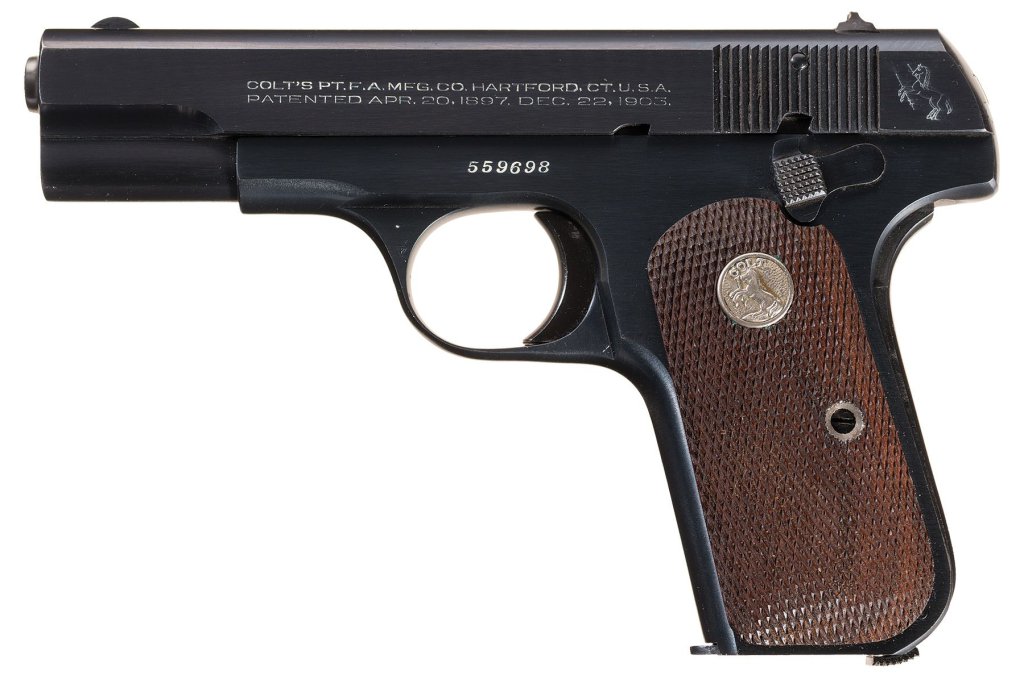
It bears mentioning that .32 ACP was popular in Europe, and that made it easy for resupply and caliber logistics with other intelligence agencies. OSS-marked M1903s have become quite collectible these days. The little guns were likely easy to carry in plain clothes and were probably often tucked into pockets and vests with ease.
The NYPD
The NYPD was forward-thinking in the early 1900s. While the majority of the officers carried Colt .32 revolvers, the NYPD issued detectives M1903 and M1908 pistols. These lightweight pistols gave their officers a fair bit of firepower for the early 1900s. The detectives were likely better armed than the average beat cop.

These Pocket Hammerless guns held more rounds than the standard revolver, and the M1908 version in .380 ACP outperformed the little .32 Colt revolvers. To teach NYPD detectives how to shoot the city of New York, hired Olympic Gold Medalist Alfred Lane.
The United States Military
Your standard General must be too fragile to carry an actual fighting pistol. That’s the joke I like to make anyway. General Officer’s pistols are typically much smaller and lighter than the standard issue handgun. The Army issued the M1903 and M1908 to General Officers, often their name and rank denoted on the guns.
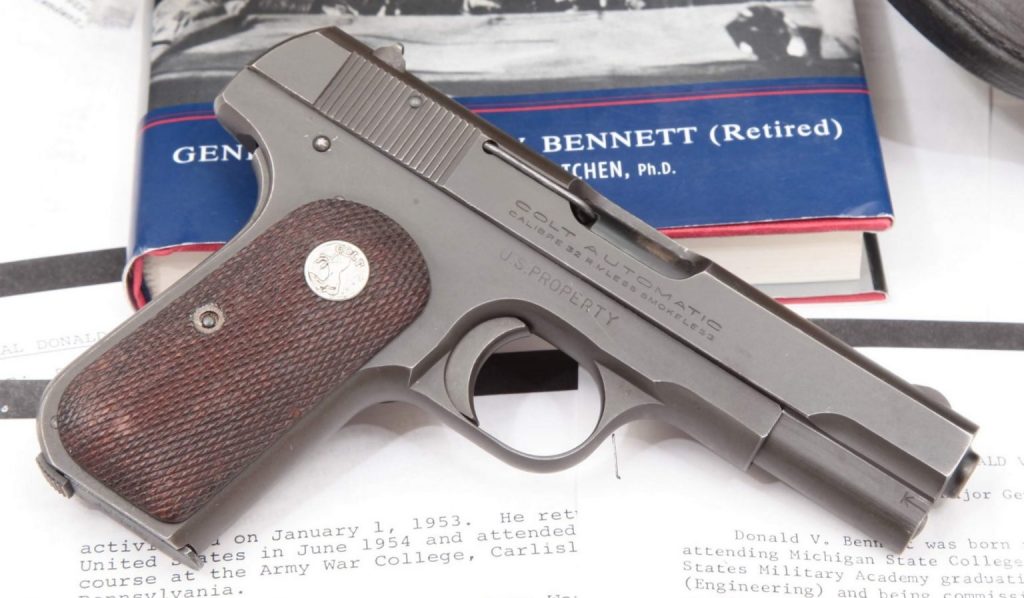
Patton, Eisenhower, Marshall, and many more carried these pistols. Surprisingly the Colt Pocket Hammerless models remained in armories until the 1970s when they were eventually replaced by the M15 General Officers pistol.
The Japanese Military
In the late 1930s, Japanese Officers were expected to provide their own handguns, and a popular choice for Japanese Officers was the M1903 Colt. Much like Europe, the Japanese stuck to smaller calibers for their duty pistols. These little M1903s were quite popular with Officers, and they were even fairly common with Japanese police forces.
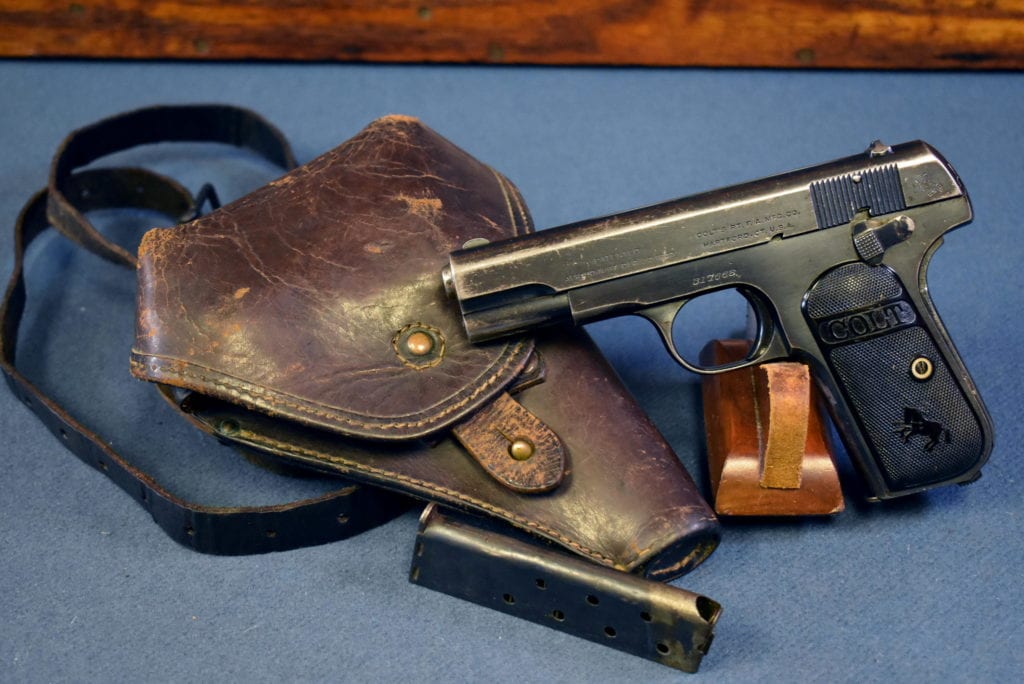
In the book Shots Fired in Anger, LtCol John George says that “All kinds and calibers of foreign handguns were carried by members of the Japanese forces on Guadalcanal, the most popular being the .32 Colt Automatic, the 30 and 9mm Luger, and the 7.65 mm Browning.”
The Shanghai Municipal Police
The Shanghai International Settlement was one of the most dangerous cities in the world. The SMP pioneered modern police work in a number of ways. This includes their gunfighting skills. Men like Fairbairn and Sykes pioneered combative shooting, and they did it with Colt Model 1908 Pocket Hammerless guns.

Their gunfighting skills were developed with the world’s first shoot house, modern move-and-shoot techniques, and even an early version of point shooting. Honestly, after shooting one of these guns, I get why they did point-shooting. The sights are so freaking small they are nearly impossible to use. The SMP was quite forward-thinking, and it shows by choosing an automatic over a revolver.
The Pocket Hammerless World
The Pocket Hammerless guns might never have been designed to be duty guns, but they most certainly served well in that role. Colt’s little guns are sleek and slim and are admittedly excellent shooters. I can certainly see why they were so beloved for so long.
(Cover Image Courtesy of Turnbull Restorations.)
The First Generation Beretta APX
Unveiled in 2016, the Beretta APX was the 500 year old gun company’s first major duty oriented polymer framed striker fired 9mm handgun. At the time of its launch, this pistol certainly was categorically nothing new since many major gun manufacturers had already been marketing some form of a 9mm striker fired polymer framed pistol. The Beretta APX, while well thought out and smartly designed lived in the shadows of its bigger rivals like Glocks, Smith and Wesson M&Ps, the SIG-Sauer P320, et al. The lack of wider aftermarket support as compared to those giants also did not help its case. However, what compelled me to independently purchase my own specimen in early 2021 was the fact that gun is a sleeper. For what it cost and the feature set that my basic no frills full size “duty” pistol has out of the box, it was certainly a deal.
To clarify, the original APX duty size handgun is no longer sold as a “new” retail item. Beretta USA has revamped their APX line and is now selling the Beretta APX A1, which is the current iteration of this pistol—it is optics ready among other things too. But this article is about the original duty sized APX, which is what I own and what I am writing about.
Even now and in spite of the fact that this particular model is no longer at the forefront of the APX family, it has it niche. Like an older Glock, this is the kind of pistol one can keep in the back of their safe to hand out as a loaner or to keep as a backup. The APX could also serve casual gun owners well, like people on a budget or those who just do not expect to shoot all that much but still need a pistol.
Upon closer inspection, it’s evident that Beretta had done its homework during the development of this handgun. As far as the guns Beretta has produced throughout its history are concerned, the APX will probably never win any beauty contests. However, when in the hand, it’s quite evident that utility and practicality were one of Beretta’s design parameters during development. The pistol’s grip is extremely ergonomic and this is something that is immediately noticeable. The grip is friendlier to those with smaller sized hands (which is another reason I think it makes a great loaner pistol). The APX also ships with a few different interchangeable backstrap grip inserts in order to suit a wide variety of users. While most semi automatic pistols have slide serrations that are carved into the material of the slide itself, the APX differs in that it has no serrations. Instead it has a series of widely spaced spines throughout the whole length of both the left and right sides of the slide. Visually, these look very odd, but in reality they are very practical and very easy to grip in order to rack the slide across all conditions—muddy, wet, frozen, bloody, dusty, with or without gloves, etc. Unfortunately, the new APX A1 does not have these spines.
Like other truly modern handgun designs, the Beretta APX also has ambidextrous slide releases and as a left handed shooter this is something I appreciate after a lifetime of having to adapt to right handed firearms. The magazine catch is reversible while it is placed in a great location where most human thumbs can actuate it. A Picatinny accessory rail adorns the dustcover underneath the muzzle. The out-the-box trigger on the 1st generation APX pleasantly surprised me. It does not have the typical spongy striker trigger. The trigger travels approximately 0.15 inches or so until it gently reaches its “wall.” Pushing past this trigger wall to break the shot is fairly pleasant. Once again, for the cost of admission, I will not complain terribly about the APX’s trigger. Because the pistol is popular amongst IPSC competitors overseas, trigger spring kits and related accessories that improve ignition are available. The same is true for fiber optic sight options. Plenty of shooters have aslo been shooting their first generation APX pistols with slide mounted red dots as well. Like the Sig Sauer P320 and P250 before it, the Beretta APX also has a serialized fire control group, so the grips and frames are freely interchangeable.
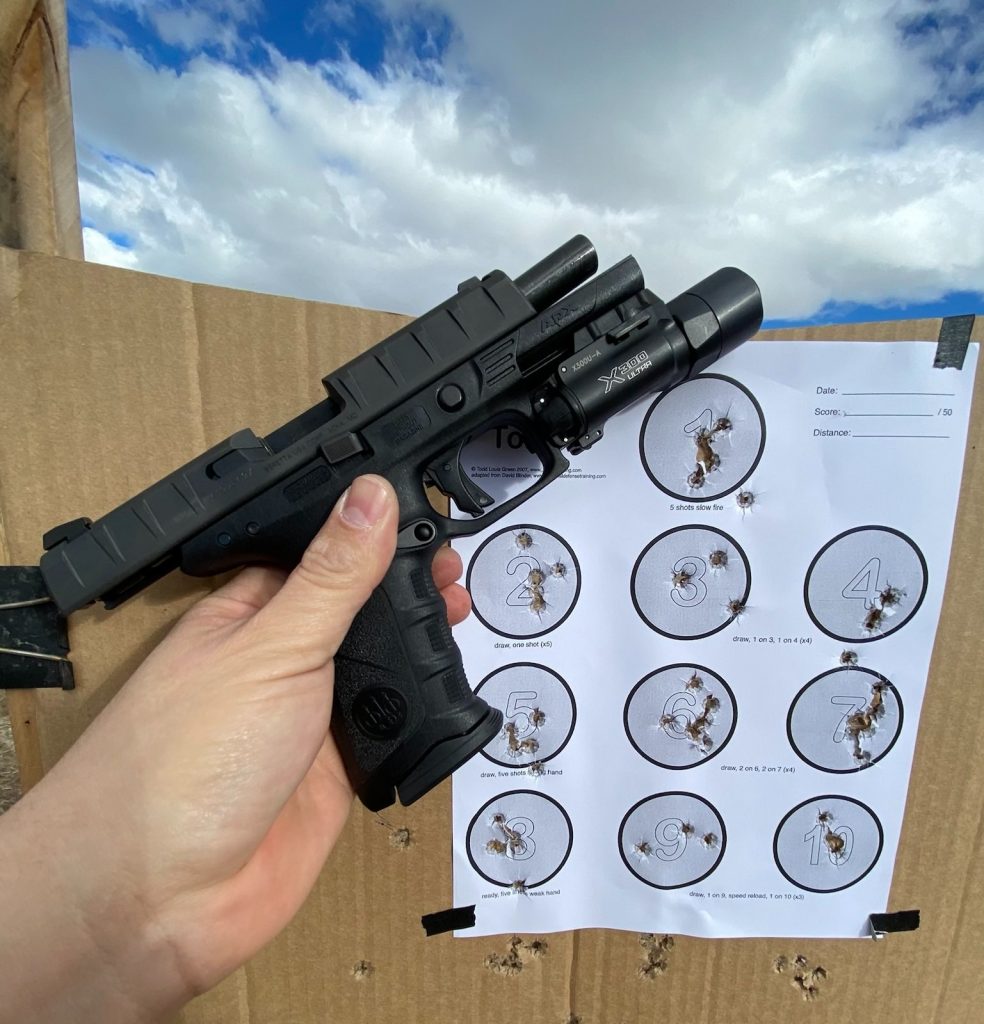
Besides their affordable prices and usefulness, the saving grace of the APX is the fact that it has many common parts that are cross generationally interchangeable with its newer brother, the APX A1. Both pistols use the same 17 round magazine and these will obviously not be difficult to find. They also share several small parts, so keeping the older generation Beretta APX afloat is not that impractical. Given the continued progress Beretta has made with the APX line, the aftermarket for parts today is probably a little more accessible than it was when the first pistols launched. I decided to shoot the Dot Torture drill for my APX’s maiden voyage.. I attached my U-Boat “A” to the accessory rail and worked from my PHLster Floodlight. All in, this was a very reasonable handgun to shoot and I would consider that a respectable five yard dot torture target. For a gun that cost me $349 retail in 2021 at a big box outdoor store not including taxes or fees, I am satisfied.
A Futurama Forgotten Halloween
In an amazing callback to Futurama, probably the best late-90’s animated comedy about space, Ian McCollum of Forgotten Weapons runs an Angstadt Arms MDP-9 at a Halloween match while dressed up as Lee Lemon, thus generating the most meta Halloween costume I can think of: a man, dressing up as a woman dressing up as a man.
The DOOP uniform, the always luxurious ponytail and perfectly shaped moustache and goatee dyed impressively purple, and of course the goggles (they do nothing!) make this costume impressively complete. If you’re a fan of Futurama, you know immediately what Ian’s doing here, but in case you aren’t, here. You’re welcome.
Gunday Brunch 75: Sometimes We’re That Guy
The boys are all back, and this week we’re talking about times that they were “that guy.” You all know that guy. We’ve all been that guy. Share your stories in the comments or via email!
SIG MK 25 Navy Model
My goal is to test and evaluate every handgun fairly. Range testing and mechanical evaluation if part of the job. Some of the new pistols are unproven and demand more attention and a critical eye. It isn’t often I encounter a firearm that is so well proven there is little I can add to the legacy. Then there are legends. The SIG SAUER MK 25 Navy Model- a development of the P226 is one of these. This 9mm handgun has been in every hot spot on earth. While the mechanics of firearms are interesting and well worth study, it is the people who use the firearms who are most interesting. As such, this is a handgun that most people approach with reverence. The type has been used in many actions, including an operation that was among the most important and successful anti-terrorist operation of all time.
Despite a US Military trail that declared the Beretta 92 and SIG P226 had parity in performance and chose the Beretta on the low bid the Navy went with the SIG pistol. Without going into detail and opening a can of worms again, it seems that, in the original competition, the Navy believed the SIG featured superior ergonomics and that, in light of certain failures during testing of the M9, the SIG is the superior handgun. Both handguns had received excellent grades and proven very reliable. While the SIG was not adopted by the U.S. Army, the P226 handgun secured thousands of police sales.
During the 1980s many police agencies were transitioning to the self-loading pistol. At the time the only home grown double action first shot 9mm pistol was the Smith & Wesson 59. It came off very poorly compared to SIG or Beretta on every count. The SIG was designed with human engineering, reliability and accuracy foremost. The original P220 single column magazine pistol is the primogenitor of a long line of successful pistol. The SIG P220 features a smooth, double-action trigger. After the first double-action trigger press, the pistol fires and the slide cocks the hammer for subsequent single-action shots. There is no manual safety. There is no manual safety, the double-action trigger is the safety feature. The handy, frame-mounted de-cocker lever allows you to de-cock the handgun easily, safely lowering the hammer to the ready position from full cock. Experienced users regard the SIG de-cocker as the superior system among service pistols.
The Michigan state police were among the first American agencies to adopt the SIG P226. The P226 is a high capacity version of the P 220 9mm. The P228 and later P229 are compact versions. It is still a modern and reliable handgun and was an innovative design when first introduced. The pistol features a double-action trigger with a smoother compression than any handgun in its class. Compared to the external drawbar of the Beretta 92, the SIG P226 features an internal drawbar connecting the trigger to the hammer. The lockup is simple but very strong. The barrel hood locks into the slide. There are no locking lugs. Angled camming surfaces lock and unlock during the recoil cycle. The SIG has no manual safety but safety features such as the double action trigger and a positive firing pin block that locks the firing pin in place until you press the trigger completely to the rear.
The sights have evolved from the original but have always been excellent combat sights. The pistol features a high-grade aluminum alloy frame and originally a stamped steel slide. The modern SIG P226 has a stainless steel slide. SIG has offered the plastic grips in a number of different configurations and stippling. Series production runs of the SIG P226 handgun exhibited minor variations on the grip-strap checkering and control surfaces. Originally, SIG manufactured the pistols in West Germany, but today, they are made in Exeter, N.H.
The SIG P226 has won many test programs based on ergonomics and reliability. The Ohio State Patrol chose the SIG P226 as a service pistol after a grueling 228,000-round test of more than a dozen different handguns. The SIG that captured first place in the OSP test was a double-action-only variant in .40 caliber. Despite being chambered for a high-pressure/high-momentum cartridge and that the action was a major modification of the original, the pistol was the most reliable they tested. Overall, it was one among other impressive showings.
The flat dark earth commercial MK 25 illustrated is among my favorite handguns. I often carry the pistol in a DeSantis Speed Scabbard. There are lighter 9mm handguns but none more reliable or with better practical accuracy. The usual finish for aluminum-frame handguns is anodizing, which often wears during service use, leaving sections of exposed aluminum. Nitron finish is much more durable. The MK25 was one of the first SIG P series to use a light rail. In this handgun the double action trigger breaks at a clean 12 pounds. The single-action trigger press is crisp and breaks at 4.25 pounds. Reset is different from most double-action pistols. You are always in control with the P226 action. Reset is not as rapid as a competition handgun, but the action is ideal for a service handgun. If desired, you may fit the SIG Short Reset Trigger (SRT). The MK 25 is supplied in a locking plastic case, along with a total of three magazines, a realistic minimum with one in the pistol, one on the belt and one resting. I have on hand a number of SIG P226 9mm 20 round magazines. They work well and make a lot of sense if the pistol is used for home defense.
I fire the pistol often when I wish to enjoy a precision handgun with more than a little history. Before firing I lubricate the pistol and load the magazines properly. I load the magazine with three rounds and tap the magazine base on the boot heel to ensure the rounds seat. Then load three more and continue until the magazine is fully loaded. gazine. I give the magazine a final rap to securely seat all the cartridges. That method ensures good feed reliability.
A pistol this size and weight is controllable with modest recoil. Drawing quickly and lining up on target as the front sight hit the target and I pressed the trigger, I had a hit. For those who practice, the SIG P226 is a pistol that responds well to the proper technique. It was no problem to put every round in a magazine into the center mass of a man-sized target at 25 yards. As for absolute accuracy firing from a solid benchrest firing position the pistol will group five shots into 2.0 inches with quality ammunition. Occasionally a superior loading and a trained shooter will put five shots into less than two inches from a solid rest.
I normally deploy one of three loads depending on availability. The Federal 124 grain HST, the Federal 124 grain Hydra Shock, and the Speer 124 grain Gold Dot. I slightly prefer the Hydra shock based on police service experience and study. There are reliable accurate loads with a good balance of expansion and penetration. There is a counter argument in wound ballistics, and some prefer a bullet that is heavier than standard, drives deeper in penetration, and has a balance of expansion and penetration that favors penetration. There is also the argument that a heavier bullet with longer bearing surface exhibits greater accuracy potential. I have found the Speer 147 grain Gold Dot very accurate. The 147 grain Federal HST offers good expansion more so than any other heavy 9mm I have tested German police in the 1970s trials demanded that the handgun be accurate enough for hostage rescue shots. The SIG P series was born out of the war on terror, and today, it continues to serve on the front line in that capacity.
Specifications
Caliber 9mm
- Action Type: DA/SA
- Trigger Pull DA: 10.0 lbs (actual weight, 12 pounds)
- Trigger Pull SA: 4.4 lbs (actual compression, 4.25 pounds)
- Overall Length: 7.7 in
- Overall Height: 5.5 in
- Overall Width: 1.5 in
- Barrel Length: 4.4 in
- Sight Radius: 6.3 in
- Weight with Magazine: 34.4 oz
- Magazine Capacity: 15 rounds
- Sights: SIGLITE night sights
- Grips: Black polymer factory grips
- Frame Finish: Black hard anodized
- Slide Finish: Nitron
- Accessory Rail: Yes
- Features: UID identification label, anti-corrosion coatings on controls and internal components, anchor engraving





The New SK Customs “La Revolución.”
HAYMARKET, VA – November 4, 2022 – SK Customs is celebrating the rich history of the Mexican Revolution with their latest series, “La Revolución.” Kicking off the historical series is the “Pancho Villa,” a gun that tells the story of Mexico’s revolutionary general, Francisco “Pancho” Villa.
“We are proud to announce our new series, ‘La Revolución,’” said Simon Khiabani, owner and founder of SK Customs®. “‘Pancho Villa’ marks the first pistol in the limited-edition production run of only 300 full size Colt 19ll chambered in 38 Super. These beautifully engraved, collectable firearms honor the Mexican Revolution, a defining historical event that lasted just over 10 years.”
A beautiful Cannas floral scroll frames a dramatic illustration of Pancho Villa on horseback galloping into battle on the left side of the firearm. Along with an engraved depiction of The Monument to the Revolution in Mexico City, the side is completed with the general’s Army, known as “División del Norte,” holding a banner with Pancho Villa’s iconic phrase, “Fusílenlo, Después Averiguamos,” translated as “Shoot him, we’ll find out later.”
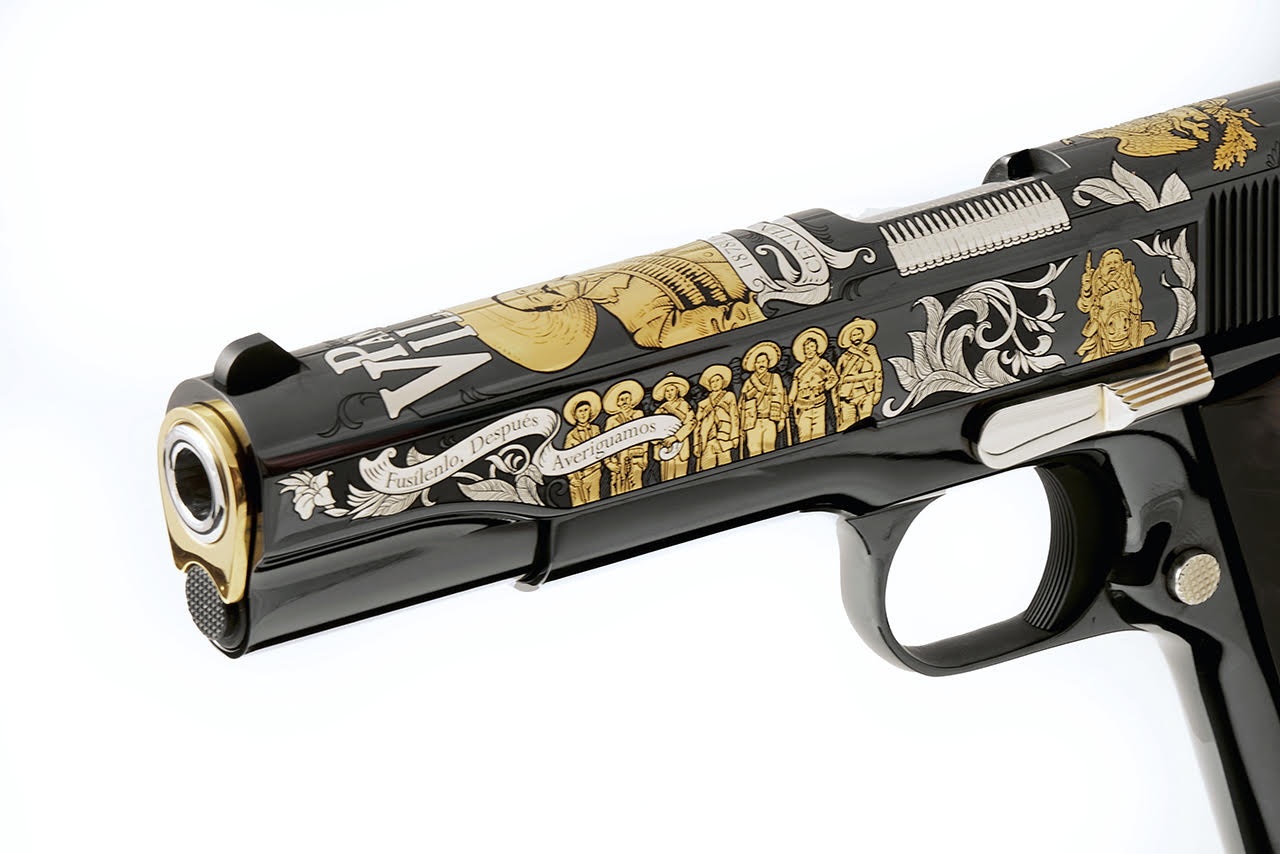
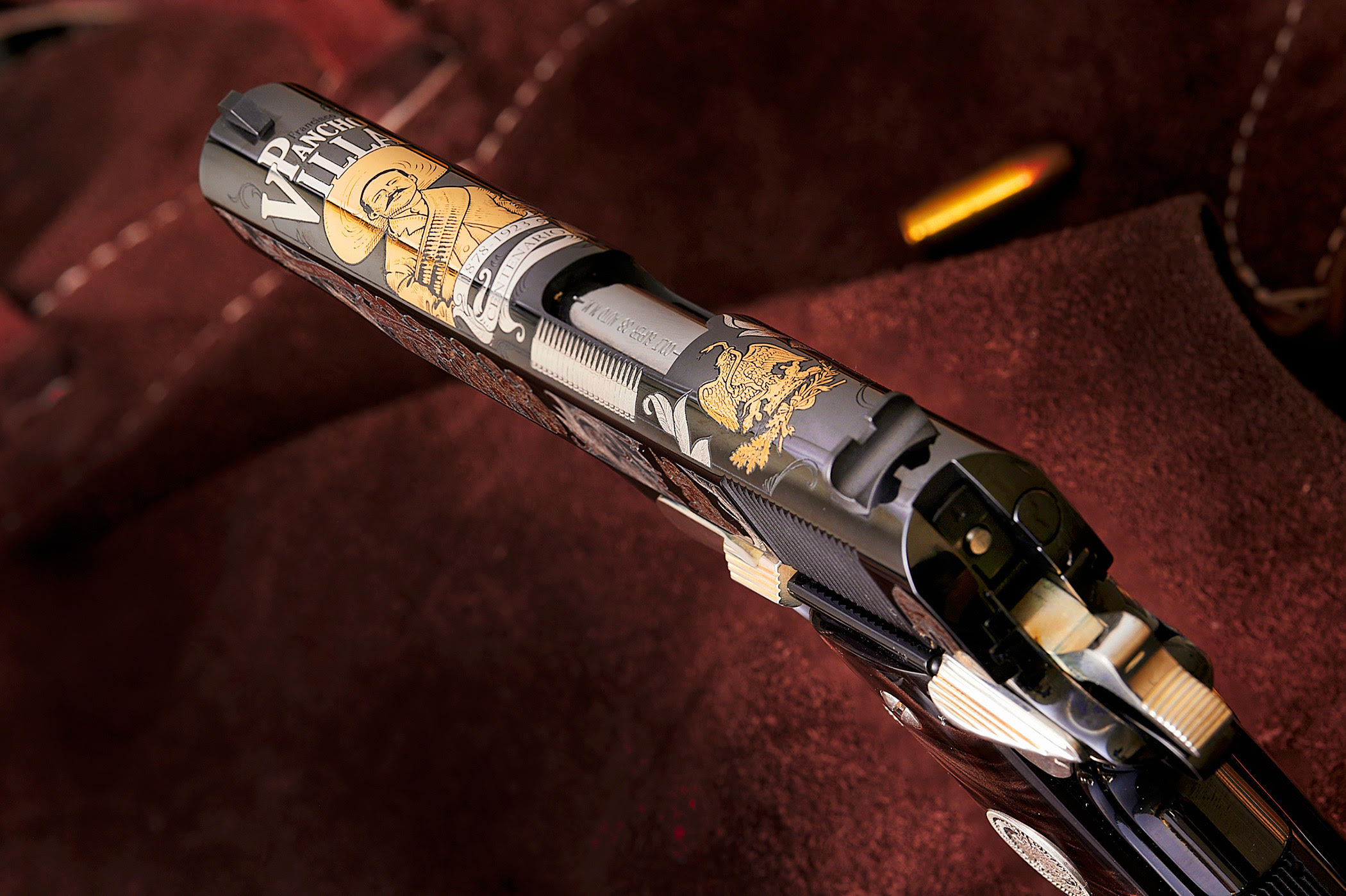
The coat of arms Free and Sovereign State of Durango emblem, engraved with “REVOLUCION,” decorate the right side of the “Pancho Villa.” Selective coverage of a Cannas floral scroll with frosted shadowing border a right profile design of the general fearlessly galloping into battle. This side of the pistol is completed with the phrase, “El Centauro del Norte,” translated “The Centaur of the North.”
An accentuated portrait of Francisco Pancho Villa titled “1878-1923 Centenaro,” signifying the 100th anniversary of his passing sits on top of the slide. The top of the ejection port showcases Pancho Villa’s Bandolier loaded with .30-30 caliber cartridges while the rear sight features Mexico’s coat of arms (1899-1917).
The gun is perfected with a highly polished frame, slide, barrel and hardware engraved with selective silver and gold plating on the slide. Custom antique gold peso medallions embellish the new Kirinite style grips for a notable finish.
Each firearm in this series includes an engraved edition number. To learn more about SK Customs® the history behind this sequence of pistols, visit skguns.com.
Follow us on Instagram and Facebook to be the first to learn of our newest production launches.
About SK Guns/SK Customs
We have changed the future in being the industry’s only series driven custom, limited-edition, production of manufactured collectible firearms. The SK Guns® brand has taken the next step to further deliver our vision on what custom limited-edition means to us by being “Uniquely Custom®”.
Our team of master engravers, expert finishers, historians, and master gunsmiths dedicate themselves to every detail within our brand of SK Customs® production lines of custom firearms. To learn more about our past, current and future products, visit skguns.com.
Taurus Holiday Rebates – G-Series
November 2022 (Bainbridge, GA) – Taurus, manufacturer of premium handguns for defense, hunting, and sport shooting, is excited to kick off summer with a rebate on new G-Series personal defense handgun purchases. This limited-time rebate covers all G-series models, including the G3, G3c, G2c, and the GX4.
From now through January 15, 2023, consumers who purchase a new G-series 9mm can receive a $50 rebate on GX4 and GX4XL pistols and a $25 rebate on qualified G2C, G3, G3C, G3X, and G3XL pistols purchased between November 1, 2022, and January 15, 2023. Rebate redemption is easy. Simply complete the rebate form or online submission with the original Taurus G UPC for each product. Include a dated copy of the receipt or itemized sales invoice and mail everything to: Taurus G Rebate, Dept. 13009, P.O. Box 5018, Stacy, MN 55078-5018.
Participating consumers can pre-qualify for the rebate by visiting TaurusUSA.com/Rebate. Rebate status can be followed at TaurusUSA.MyCheckStatus.com or by calling 844-567-8041.
Since their introduction, the G-series semi-autos have led the polymer striker-fired personal defense handgun segment for their reliability and class-leading performance-to-price ratio. With models ranging from the full-size G3 to the micro-compact GX4, and with available T.O.R.O. optic mounting options, the G-series offers EDC and deep-concealment options to meet any lifestyle and carry requirements.
Taurus G-series handguns are noted for their accuracy, dependability, and exceptional ergonomics that accommodate shooters of all sizes and experience levels. Now Taurus consumers can enjoy even greater value when they purchase a new G-series 9mm through January 15, 2022.
For more information on the award-winning Taurus G-series handguns, go to TaurusUSA.com.
Musket on Speed
The M16A2 was the rifle I entered service with. May 2007 I was handed a mostly purple FN M16A2 with scarred handguards and no finish left on the exposed barrel. This was the US fighting rifle standard and the M16A4 and M4/M4A1 were not in wide circulation yet. Most of the ones in US hands were already forward in Iraq and Afghanistan, and they were kept there since they were in short supply. The advanced optics stayed in country too.
So yes, back in my day I shot with iron sights.
The M16A2 personifies what 5.56, good range set irons, and a 20″ barrel can accomplish. Speed helps the system beat wind at greater distance. The mass of the system keeps recoil very low.
The ability to repeatedly place rounds onto target at the limits of a weapon’s effective range are a hallmark of a shooter who knows what they are doing and can complete the shot process. The rifle can hit 600 meters (as shown in the video) and the A2 has an 800m setting for an “area target”
What Josh and Henry show here is the combination of a rifle’s raw potential, decent environmental factors, and familiarity with what all the tools of the system can bring together. It nicely showcases how all the parts of a shooting system matter, especially the shooter.
A familiar rifle is a comforting thing. That old saw about “beware the man with one gun, he probably knows how to use it…” has a kernel or two of truth when it comes to a knowledgeable shooter. Ownership doesn’t equate to skill, but skills will tend to bias one towards a system they are comfortable running all the controls for, even if it isn’t the latest and greatest. One must be objective, one must be self honest, one must be humble about how honed the skills are. Lots of owners out there, far fewer users.
Chasing gear is fun, but nothing replaces proficiency.
Tests And Standards
Recently, I took Citizens Defense Research Tests and Standards course for the third time. I have been fortunate to see this course’s firsthand evolution and progression since the first time I took it in 2019, when it was still a one-day class. What the course currently offers is a night and day difference from that first time I shot it. And even then, it had something to offer.
Test and Standards is a relatively high round count (for 2022 standards (pun fully intended)) two day course of approximately 500-700 rounds that focuses on purely technical pistol shooting skills. The course and the instructors cover every aspect of making a pistol shot, from the time the pistol is first drawn through the end of a string of shooting. All shooting is done either at three or five yards, and students deliberately shoot at smaller targets such as one inch squares or two inch circles. However, the biggest aspect about this course and perhaps the reason to take it is the fact that there are few open enrollment courses that offer the level of individualized feedback and evaluation from the instructors that Tests and Standards provides. The instructors filter through the entire group of students and take notes on every individual. Afterward, students will go through a series of one on one coaching and evaluation that includes a “diagnosis” to their shooting ills and the “prescription” to improve whatever pistol malady they may suffer from. Students are encouraged to focus on this throughout the remainder of the class.
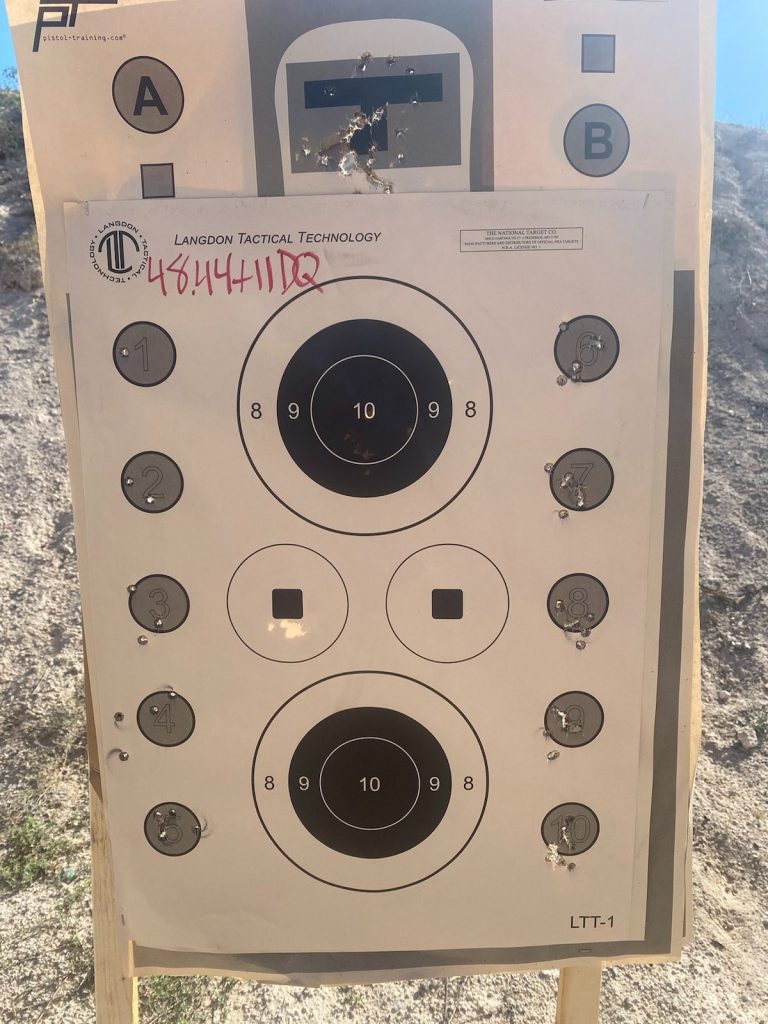
The other huge aspect that students may not likely find anywhere else is the fact that this class includes a good amount of individual and group dialogue about shooting itself. With the level of discourse and insights offered by the instructors, I’d suggest to the prospective pupil to bring a notebook and be prepared to take copious amounts of notes or some type of audio recording device. The sort of feedback students gain along with the individualized attention are worth the price of admission. These instructors have a knack of analyzing their students to a deep extent and in ways I have not witnessed at other shooting courses. Personally, every time I’ve taken Tests and Standards I have been able to improve my shooting ability and I become that much safer and faster. I distinctly recall learning very safe appendix-carry reholstering habits during my first class that are ingrained in me to this day. During the second and third times I’ve taken this course, the instructors have helped me not only develop a faster and smoother draw but also gain confidence in the skills I already had within.
It wasn’t until the last iteration of Tests and Standards that I participated in when I realized just how richly detailed and nuanced the group discussions provide. More than once I have seen miracles on CDR’s firing line occur over the course of one weekend. Some of you are probably reading this and you know who you are. I have witnessed the instructors touch and connect with their students to the extent that grown men have been brought to tears after overcoming some type of mental or habitual shooting hurdle that was setting them back from shooting as well as they could. I mentioned previously how I have been party to Tests and Standards’ evolution from those one-day classes into what it currently is. Citizen’s Defense Research deserves credit for always striving to pro-actively evolve their classes and their efforts in keeping their material relevant. That very first class felt like running a battery of shooting drills and tests under organized coaching (good coaching might I add), but this latest rendition challenged students to take into account their internal moods and feelings when shooting. This is impressive because Lanny Bassham, the competitive Olympic shooter who wrote the book, With Winning In Mind, leans heavily into some of these internal state concepts.
Aside from the material and discussion topics, it bears mentioning that Citizens Defense Research strives to provide the best learning environment possible. The instructors constantly remind students to stay hydrated and during the last two iterations I have personally attended, they provided awnings directly on the firing line. The shade certainly ensured that everyone had a better time while avoiding sun fatigue: something that can drain anyone after a few hours. After all, as students we spend so much time and effort traveling and attending private shooting courses. So why should we diminish the return on our investment by distractions like sun fatigue and unnecessary loss of energy when they are easily avoidable?
Tests and Standards does not require any exceptional or advanced shooting ability, per se. With the individualized coaching, the instructors have something to offer shooters of every skill level or demeanor. The only real requirement asked of prospective students is a focus on safe firearms handling and a safety mindset. Moreover, the class is gear and pistol agnostic. Most any reasonable holster, whether carried openly or from concealment is welcome. (Maybe leave the SERPA at home though). Red dots or irons sights, it does not make a difference because Citizens Defense Research will help you get the most out of each system. I would like to point out that revolvers are not the best choice for this specific course as most of the drills and exercises are set up around a semi automatic handgun with a magazine that holds at least fifteen cartridges. Prospective students would do well to show up with no less than 800 rounds and at least six magazines, to be safe. That said, CDR is very mindful about the usefulness of each trigger pull and they avoid needless blasting.
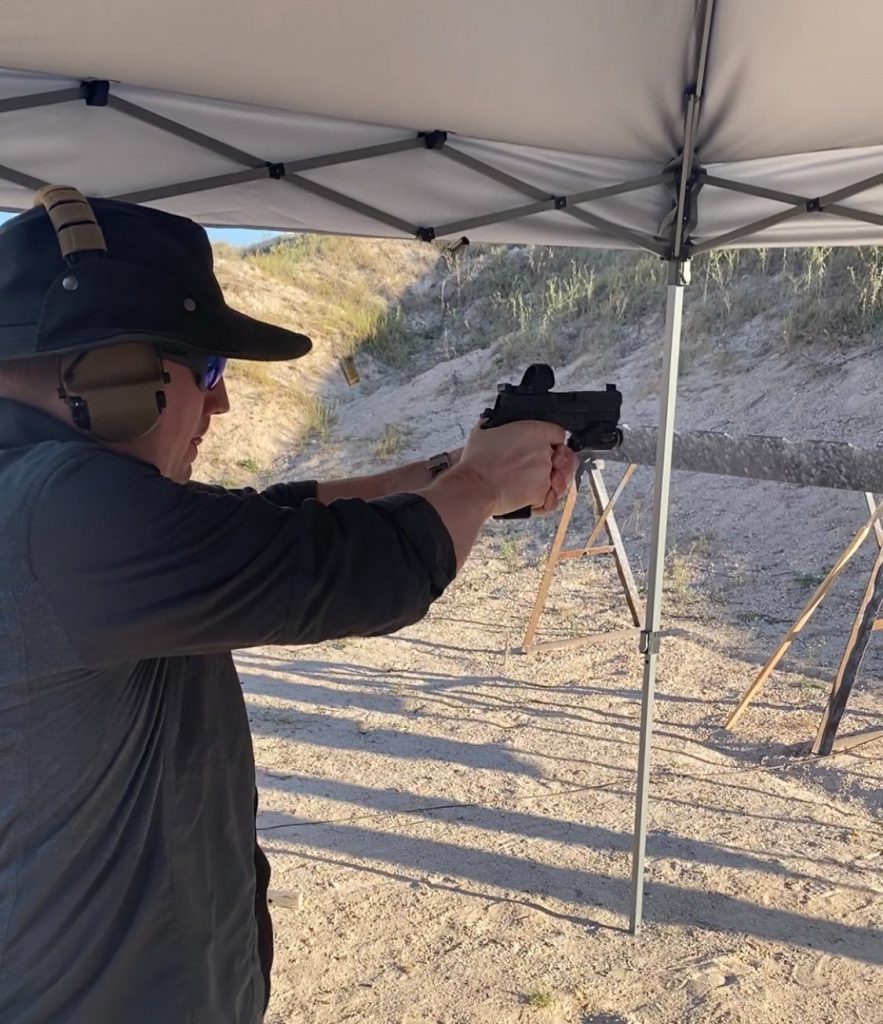
Safe shooters of any skill level interested in expanding their shooting awareness, analyzing their personal shooting process, and doing the work will probably gain something from taking this outside-the-box pistol class.
The Audley Safety Holster – Modern Retention in 1914
We take for granted the number of awesome holsters available these days. It’s tough not to. There is an overwhelming number of excellent holster designs. Back in the day, this wasn’t the case, but in 1914 a man named Francis Audley designed the Audley Safety Holster, which would continue to influence holsters today.
Francis Audley was a leather craftsman who traditionally worked on horse tack. As vehicles rose in prominence, Mr. Audley looked for an alternative source of income. This led him to make holsters. He made many styles of holsters, but the Audley Safety Holster was his claim to fame.
What’s So Special About the Audley Safety Holster?
The holster was innovative, and he wisely set up a shop across from the NYPD headquarters. This built-in customer base allowed his innovative design to get some wind under its sails. The Audley Safety Holster used a unique retention device. A small metal tab locked around the trigger guard and kept the weapon in the holster.
To draw, the user pressed the tab inward, and this released the pistol. Admittedly this wouldn’t quite pass muster today. However, it was 1914, and things were a little fast and loose for the time. Prior to the Audley Safety Holster, the only method of positive retention was a great big flap that covered the whole gun. This was rarely fast and hardly accessible.
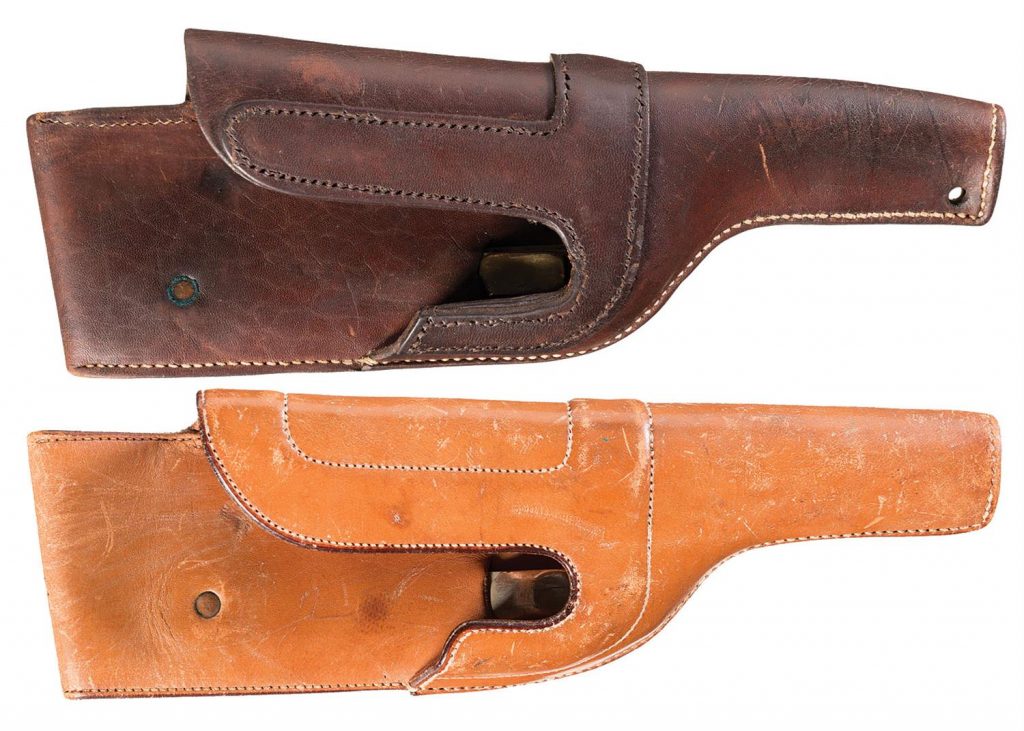
The Audley Safety Holster allowed the shooter to draw a fair bit quicker while keeping active and positive retention over the weapon. A bad guy couldn’t fight the weapon away from the user, and it could essentially only be drawn by the user.
There are some glaring safety issues with this design. However, it’s worth noting that automatics were traditionally carried with an empty chamber in this time period, and the long heavy trigger of a double-action revolver was considered safe enough. It was also the first of its kind, and we didn’t have the same vein of knowledge then that we have now.
These days duty holsters that contain those features are common, the standard, really. In fact, companies like Safariland and Vista Outdoors both cite the 1914 patent of the Audley Safety Holster in their designs.
Who Used The Audley Safety Holster?
The Audley Safety Holster was designed for numerous firearms, including the 1911, full-sized revolvers, the Colt M1903/1908, Baby Brownings, and many more. Sadly Audley never got to see the success of his pistol holster. He died in 1916, and the H.D. Folsom company acquired his patents.

The holster was fairly popular, but an incident in 1922 brought in a massive amount of orders to the H.D. Folsom company. A police officer named Patrolman Motz was murdered inside a police station when a criminal took his own gun away from him. Commissioner Enright then ordered every man of the 12,000-strong NYPD to equip themselves with an Audley Safety Holster. He also opened a shooting school and encouraged the men to practice their draw with an empty gun.
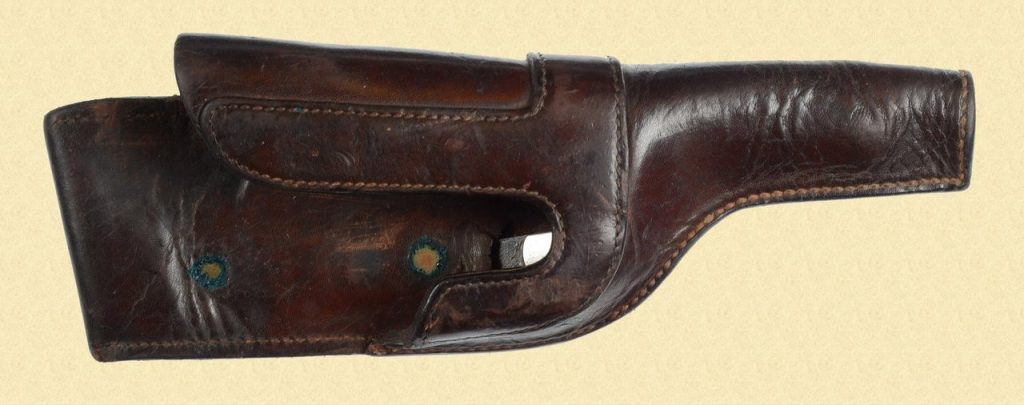
The holsters also found a home with the OSS. However, it seemed like most OSS men provided their own holsters. Roger Hall, an OSS agent and Jedburgh operative carried his Colt M1903 in an Audley Safety Holster. The holsters continued their production until the 1960s or so, when they were eventually replaced with various designs.
Looking Back
The Audley Safety Holster changed the game for combative-oriented holsters. It was the first modern holster to feature an easily defeated retention device. While it wasn’t perfect, it did create a new genre of duty holster, and it’s one we benefit from to this day.
(Cover Image Courtesy of Forgotten Weapons.)
5.11 Announces New Footwear for Fall 2022
COSTA MESA, Calif. (Oct. 26, 2022) – 5.11 Tactical®, the global innovator of purpose-built apparel, footwear and gear, today unveiled an expanded lineup of footwear available this fall, including updated models, expanded colorways and the introduction of all-new items.
“As many public safety professionals, outdoor enthusiasts and training experts know, footwear is an integral piece of gear,” said 5.11’s Vice President, Global Product, Matt Page. “Without proper footwear, even the most routine tasks can become difficult, which is why we strive to provide functional and comfortable footwear for a wide range of activities.”
The A/T Ranger 2.0 ($110) features 5.11’s All Terrain Load Assistance System Technology (A.T.L.A.S. Technology) that provides complete support, whether on a job or a hiking trail. A removable support plate creates extra support when there are heavy loads to carry. The breathable mesh construction keeps feet cool while the scratch rubber toe cap adds durability and protection. The outsole is patterned with a multi-direction lug design for maximum grip on any terrain while the Ortholite® insole is combined with a 5.11® Echo Lite high rebound EVA midsole for maximum support and comfort.
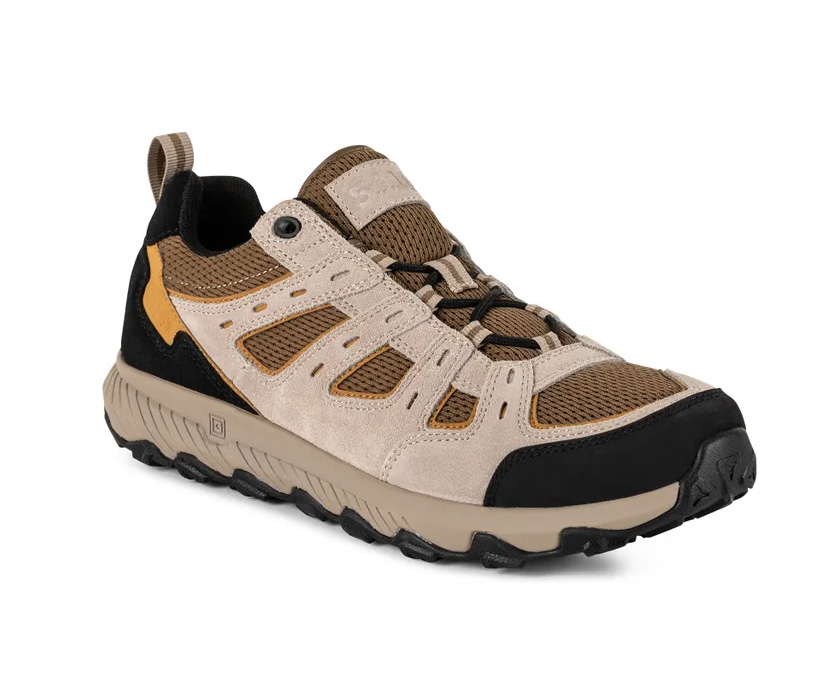
The A/T Mid Boot ($150) has been expanded to offer a new coyote colorway. This customer-favorite also utilizes 5.11’s A.T.L.A.S.technology to distribute weight, improve stability and return energy to offer all-day support, performance and comfort. Additional features include a 3D molded TPR toe and heel for protection, a welded-mesh upper for breathability and a high traction outsole.
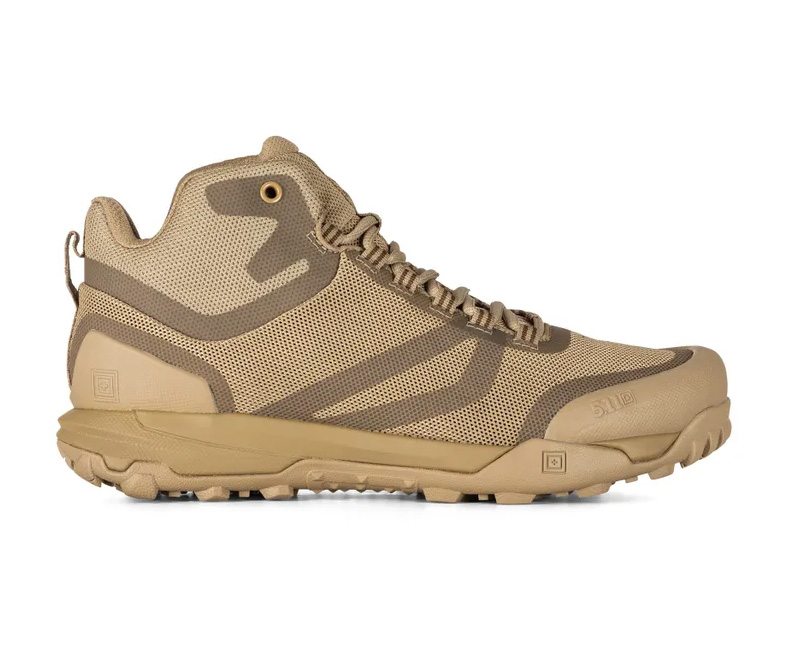
The Norris Sneaker ($115) is now available in a volcanic colorway to give customers additional styling options with this durably but casual, high-top sneaker. Offering an outstanding blend of style and functionality, the Norris features a Vibram® Marbrani outsole with XS Trek to provide traction and durability along with Ortholite® technology that cushions with support and comfort. It’s ASTM certified for puncture resistance and built with a super-strong Welmax board that protects feet against up to 1,200 newtons of force.
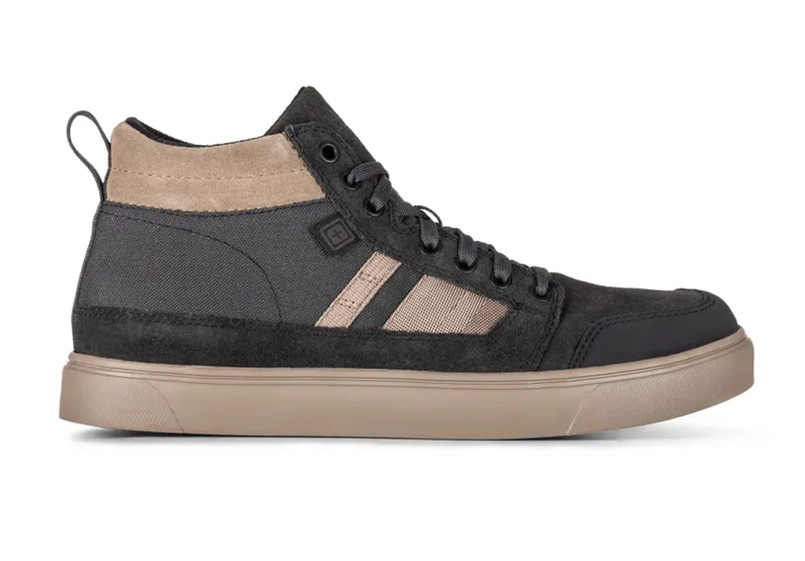
A new High Gloss Duty Oxford ($100) has been introduced for those who serve and need a dress uniform show that feels as good as it looks. The high-shine patent leather upper creates a clean and professional style while an Ortholite® footbed provides increased cushioning and a tough Vibram® outsole offers functionality.
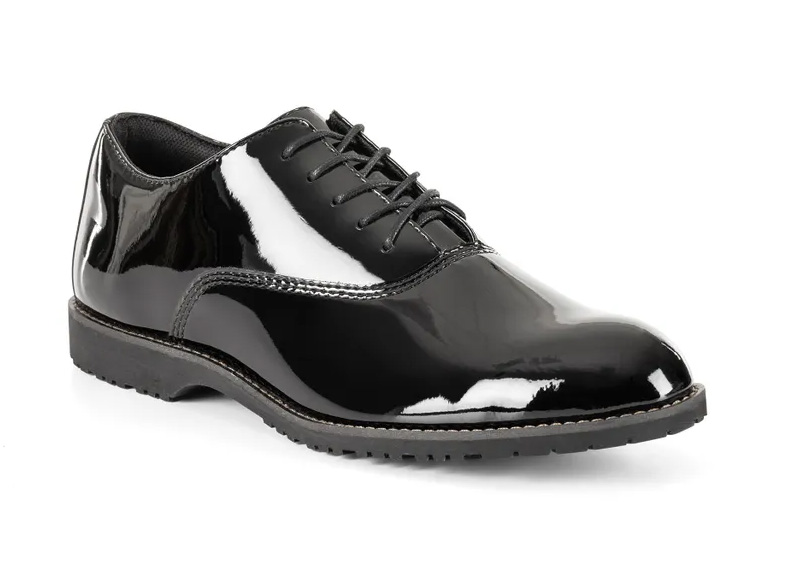
For more information about 5.11, its product offering and to find a 5.11 store near you visit www.511tactical.com.
# # #
About 5.11, Inc.
With offices around the globe, 5.11 works directly with end users to create purpose-built apparel, footwear and gear designed specifically to enhance the safety, accuracy, speed, and performance of tactical professionals and technical enthusiasts worldwide. 5.11 products exceed rigorous standards, which have allowed the brand to establish a reputation for innovation and authenticity, and become the premier choice for those who always have to be ready. 5.11 products can be purchased online, through authorized dealers and retailers, as well as at 5.11 company-owned retail stores.
Learn more about 5.11’s best-selling gear and accessories at www.511tactical.com. Find a full list of 5.11 company-owned retail stores at https://www.511tactical.com/locations/. Connect with 5.11 on Facebook, Twitter @511Tactical and on Instagram @511Tactical and #511tactical
5.11, Inc. is a subsidiary of Compass Diversified (NYSE: CODI).
5.11, 5.11 Tactical and Always Be Ready are registered trademarks of 5.11, Inc. All rights reserved.
Practical Applications of the New I-Vis Revision Lens’s
“Our new I-Vis technology provides wearers of ballistic eye protection the most accurate view of the world around them. I-Vis lenses increase the separation of colors so that when you’re wearing them, you’ll see multiple shades of a color compared to the single shade you’d see with the naked eye or when using traditional lens tints,” says Revision CEO Amy Coyne. “The result is greater awareness and faster reaction times. In a military setting, this translates into greater survivability and lethality.”
Revision has been a household name when it comes to Military and Law Enforcement Ballistic Eyewear. With a comprehensive NSN list it has been the main eye protection choice. Full List Here.
The information on I-Vis is going to be derived from attending the two day Revision Release Event for I-Vis held in Ketchum, Idaho. During this event we attended a briefing about the eyewear and the science/technology behind it. We then traveled about 20 minutes outside of town to a great high altitude hiking trail. Before the hike we did some identification of items hid within a small area, and then went on a professionally guided hike to spot mountain goats. The next day we did target shooting, both long range rifle and clay shooting with a professional eye doctor and expert clay shooter. Those who attended the events were mostly civilian with a small amount being prior military.

Quick Overview of I-Viz
Now, Revision has given us a complete set of technological advanced lens’s that are environment oriented, I-Vis. Prior to I-Vis, Revision gave us three main lens’s on the Stingerhawk frame, The clear, dark and yellow hue. Now we have six lens’s that are directly matched to the environment users are operating in. No, these lens’s aren’t changing the environment that we are looking at, they are simply enhancing details within it.
“More than a single solution, I-Vis lenses are available in six tints, each optimized for use in a different environment. With the power of artificial intelligence, Revision accounted for theater-specific color vision variables that take into account the color palette of locations while modeling the most likely lighting conditions to occur in that area using global data from the National Oceanic and Atmospheric Administration (NOAA).”-Revision

Food for thought: Next time you look at the newest release of eye pro on the shooter market, look at the color of the lens’s and how they interact with the environment. Do they change the color of the items? This will actually tire the brain out as items are being processed due to your brain thinking “that steel that is supposed to be white is now yellow” instead of “that white steel is still white just easier to be seen and more detailed.” There is a difference in lenses enhancing the environment or changing it. To do this, in simple terms, they used the color world instead of the well-known color wheel. The color wheel is a small portion of the colors that we see. When we look at the environment with our naked eye we see greens, browns, and reds. With I-Vis though we see multiple colors of those greens or reds. Revision went to that color world and found the slew of colors that are found in various environments, and created a lens that enhanced those specific colors.

The Lenses
Each lens is made with ancient Greek names to insinuate that type of environment that the lens is made for. For example, Alto meaning to raise, elevate. This lens is used for high altitude environments. So on so forth.
Note: The VLT rating noted in each lens photos stands for Visible Light Transmission. This is the amount of visible light that can pass through the lens. The lower the VLT, the darker the sun lens will be.
For instance, the Umbra has a higher percentage because it is meant to be used in a clouded snow environment, needing a lighter lens. The Clara showing a VLT of 12, lower than the Umbra, due to being used in a sunny environment and needing to shield some of that light out.






Practical Applications
With all of this talk about Military specific eyewear, let us not lose that these are made for civilian application. We are all “operating”” in specific environments. Whether that operation means shooting a match in the high desert, hunting in the dense woods, or finding bighorn sheep in the mountains of Idaho (we did this at the Revision media event). We as civilians deserve the same Ballistic eyewear that those running missions in the jungle are wearing.
Shooting a Match
Fun Fact: A cool thing about the technology behind these lens’s, the lens curve and design is actually made to appease a shooter using the top right or left corner of the lens but yet also the center. Think of when mounting a rifle, you are now looking through a different part of your eyewear. Working with a professional eye doctor, Revision designed the lens to work while looking through the middle of the lens and the side.
Field Match
A long range field match really lets this eyewear shine. While it is understood that many who shoot bolt gun or long range in general do not wear eye protection, this eyewear will only help, not hurt. A large part of field matches is spotting your target. Oftentimes in various disciplines such as NRLHunter matches of Competition Dynamics matches they will make the shooter spot and range their own target. Seeing details in a large area is huge in this discipline. Let’s say we are shooting in Grand Junction, Colorado (though we aren’t anymore due to their high capacity magazine law, but I digress) This environment is full of light browns and tans due to it encompassing a high desert feel. While our naked eye sees a lot of one color, the true color of the environment is actually made up of many of those tans, just like the color world we talked about earlier. To spot a steel white/gray/brown target within those tans and browns that detail of the target needs to stand out to your eye to find it and range it properly. The I-Vis Lens Aros would be the lens to choose for this environment.

Flat Range
Use on a flat range uses the same values as before. Find your target, keep your eyes safe, and don’t tire your brain or eyes out. While many glasses on the market for flat range pistol shooting is of a yellow tint that changes the color of targets, these lens’s don’t do that but still allow for the same protection and enhanced visualization. For flat range shooting say USPSA matches the lens Cano or Verso would work well. Remember though, all users see things differently, it’s on the shooter to really dial in which lens works best for THEM and in which environments.
If using a red dot, the lens will not impact the red dot but instead enhance it without bloom. So the red dot can be on it’s lowest setting and still be seen well due to the detail coming out.
Snow
To go with the flat range shooting lens type, remember that snow can alter the eye drastically whether it is sunny or cloudy. Revision I-Vis gives us two different lenses for this environment.
Personally, this is my favorite part of the I-Vis line up. The lenses Clara and Umbra are made for either sunny snow environments or cloudy snow environments. This can be applied both on a flat range when it is so sunny and the sun is reflecting off the snow that your eye will be stressed and need some shade and in a field match when everything looks the same. White snow, white targets. These lenses won’t darken everything but instead brings out contrast within the whites and blues.
Hunting/Tracking
One story that was brought up during our brief is the use of I-Vis while tracking. Many users have stated that they noticed moved dirt with the lens vs not. Remember these lens’s work to bring out the detail and colors that are already there, not create any. Dirt being moved will be colder than stagnant dirt or land. This can be used for noticing tire tracks as well.
Hunting is all about spotting animals in environments that these animals are meant to be hidden. Noticing detailed and differing colors instead of the same overall browns/tans/greens will help spot and track those animals.

Target Identification
During the Revision I-Viz event there was an exercise where we would put on the older Revision yellow tinted Stingerhawk glasses and find items hidden in a small area within the woods. Items such as green army men, blue bandanas, boonie hats, etc. The number of items that we found would be tracked. We then would put on the Cano Lens and spot the same items. For myself specifically I found about 5 more items with the Cano lens than with the yellow tinted. This is due to details coming out within that environment due to the lens being made to see those colors from the color world. Blues were now popping, different greens, instead of all a yellow tint.
A story was told about an Arborist who was trying out I-Vis. Part of his job is to find trees infected with fungus. He is trained to do this with the naked eye. After putting on an I-Vis lens he stated that he saw a leaf with the red fungus color from over 50 yards away, compared to having to look close with the naked eye. The I-Vis lens made that color of red pop instead of blend.
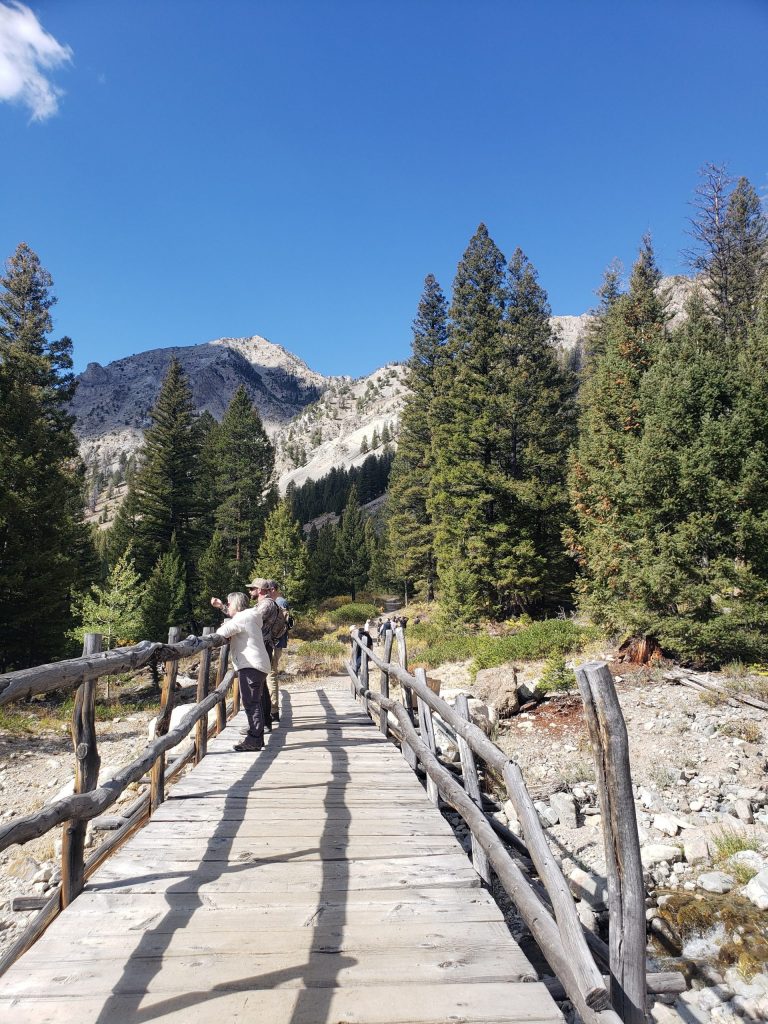
To Purchase
Just as these Len’s were made for everyone, military, LE, civilians, they can be purchased by all. See the local dealers list HERE to purchase. In the dropdown it helps to select “everywhere” as the location. That will give you all of the online sites.
The Machete
The ball bat, stiletto and machete have certain cultural and practical histories. I have seen all deployed- as well as butcher knives, tire irons and golf clubs- in violent encounters. Then my wife reminded me of the box cutter- you get the picture. For all around hard use in a more pleasant setting the machete is possibly the king of edged tools. I own quite a few. I even have a couple on hand as bad examples! The machete saw extensive use during World War Two and the various banana wars. People all over the world rely on machetes. Compared to the Kukri or Bowie knife the machete has certain advantages in preparing food clearing brush and in some types of harvesting. The machete is a good tool in its best forms. I suppose the machete may be termed a multi tool. As a point of interest many police in South America, especially Cuba, were armed with a machete. They were taught to strike with the flat of the blade and to swing the sharp edge in an arc to break up riots. The threat was usually enough. The machete was a very important weapon in the revolution against Spain.
The best piece of advice I can give you is to avoid the cheap flea market type machete. These tools are so thin the edge doesn’t last long. They may be ok for whacking a few weeds but if you put them to heavy work you will find them very uncomfortable. The impact is transferred to your hand by the tool and a handle that doesn’t cover the metal of the machete. Among the best machetes in the world is the Linder. These feature a stainless steel blade. The 44905 features strong well designed wooden handles and an eighteen inch blade. The 449036 features a fourteen and one half inch blade. These machetes run from about thirty to less than fifty dollars average retail. I paid about that for mine more than twenty years ago. Camillus offers an affordable mini machete that stretches the definition but the thing comes in handy and is easy enough to carry. I also have a 1942 Collins Signal Corps issued machete. It is well balanced, light enough, and satisfying to use. I also have on hand a no name Chinese monstrosity that appears made from tool steel. It has saw teeth on top of the blade that are too dull and large for any use. The blade, however, is pretty tough. It is more of a short sword design than a machete but has a finger cut out in the choil. It isn’t the best five dollars I have spent but it works and if I break or lose it no big deal. I wrapped the handle with electricians tape and it works OK. For coarse work it succeeds. I have even dug rows for a garden with it.
I haven’t cut my own trail in some time but I have traveled on pretty poorly kept trails. The machete will clear a trail like nothing else. Don’t always use the edge. Slap aside foliage and cut when necessary. Take a good one on this type of trip. The design of the blade works well in this environment. There is plenty of leverage with a large handle relatively thin blade and a flat surface. You will wear yourself out attempting to chop away every obstacle. Whack the brush aside and work at its weakest point. Watch out for creepy crawling things.
If you have visited the Caribbean for any length of time you may have seen sugar cane and rice harvested with a machete. This is the preferred tool. The agricultural machete may be a bit different than the general use machete we deploy on the Appalachian Trail but it will work well enough. For some specific chores the tool is so large it is really a sickle- and we know the use the Bolsheviks got out of the sickle! A bill hook tool is sometimes used. Machetes are great for poking around camp fires with no danger of being burned. There is also much utility in the design for weeding out a garden. For these uses I find the eighteen inch blade a bit large and heavy and I think that after some trail and error the fourteen inch blade is about ideal. But there is plenty of room for personal choice. Machetes are great for clearing vines from brick and fences. Unless you get the roots the stuff grows back but in the meantime a machete really helps in shaping the yard up. While you are at it you may have the occasion to chop the head off a reptile. There is plenty of leverage and the machete offers a firm smack and plenty of weight for this chore.
I think an axe is better suited to preparing kindling for a fire- but it depends. A good machete is plenty strong for kindling if a little light for some things. If you have a good thick handle that prevents the machete’s metal from contacting you hand you may use this tool effectively. It depends on the problem at hand and the size of the tree. A machete is a great all around camp tool useful for making a hasty shelter and even preparing food with some practice. Maintenance, clearing, and collecting kindling are common camp chores. Building a shelter demands you are able to chop poles and also cut out enough material for a roof. From a one person shelter to larger shelter a machete makes short work of a lot of brush. Whichever type you choose don’t neglect maintenance. Wipe the machete off from time to time to prevent wood material from getting ground into the edge when you sharpen the edge. Don’t forget stainless machetes are just that stain-less and will rust, they simply are more resistant to rust. This isn’t a tool with a lot of bling factor but it is an indispensable piece of gear.
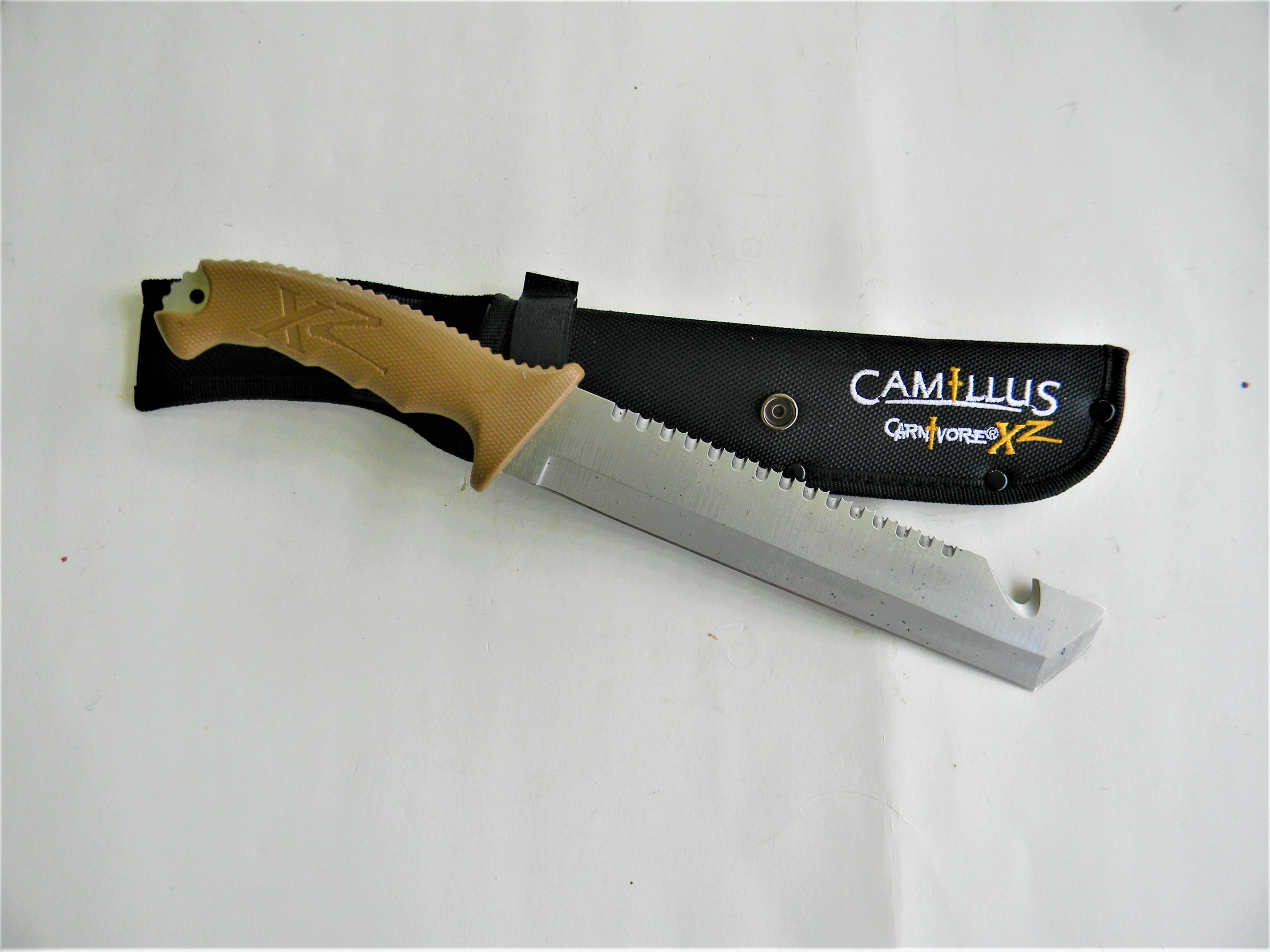
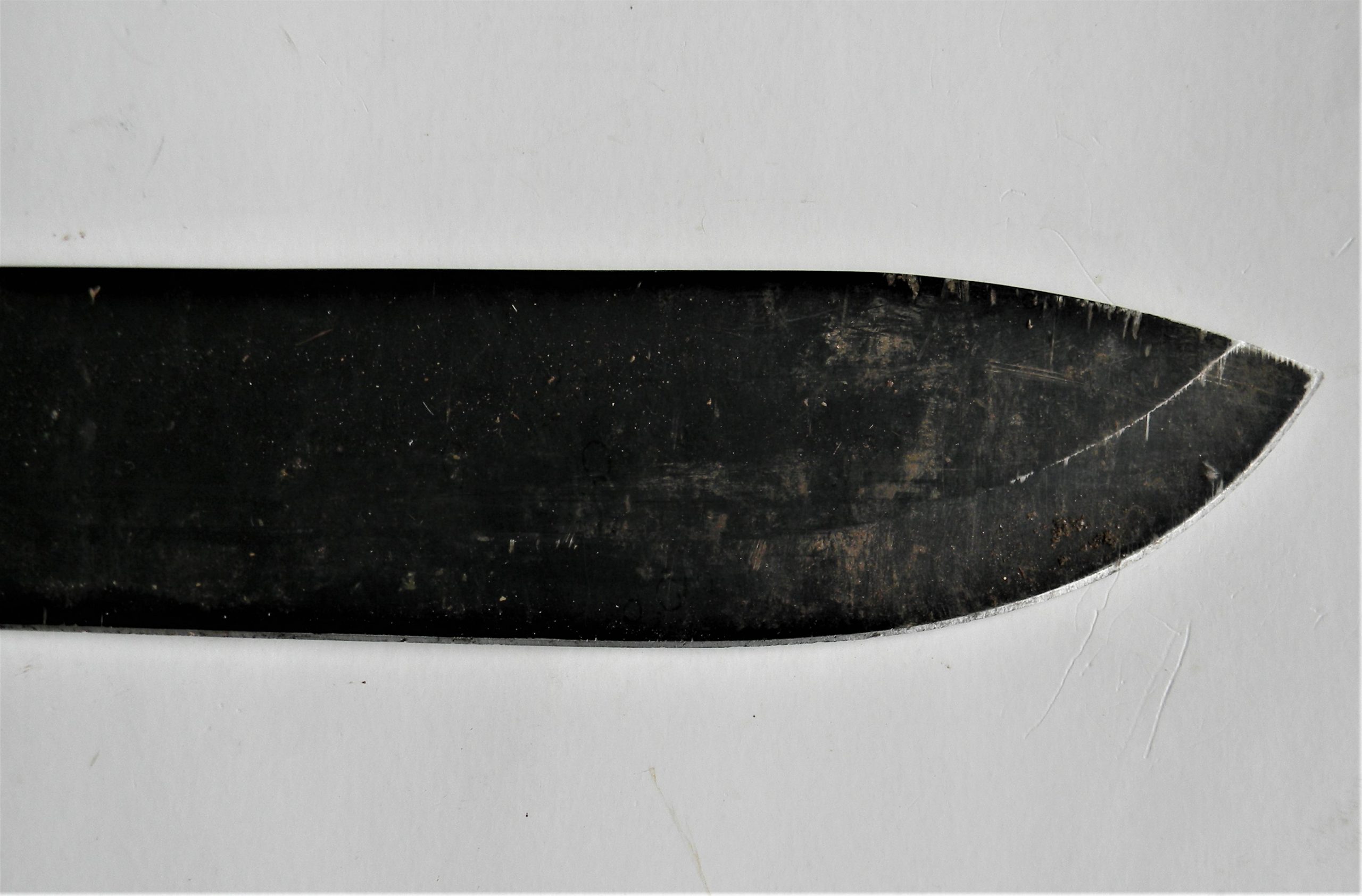
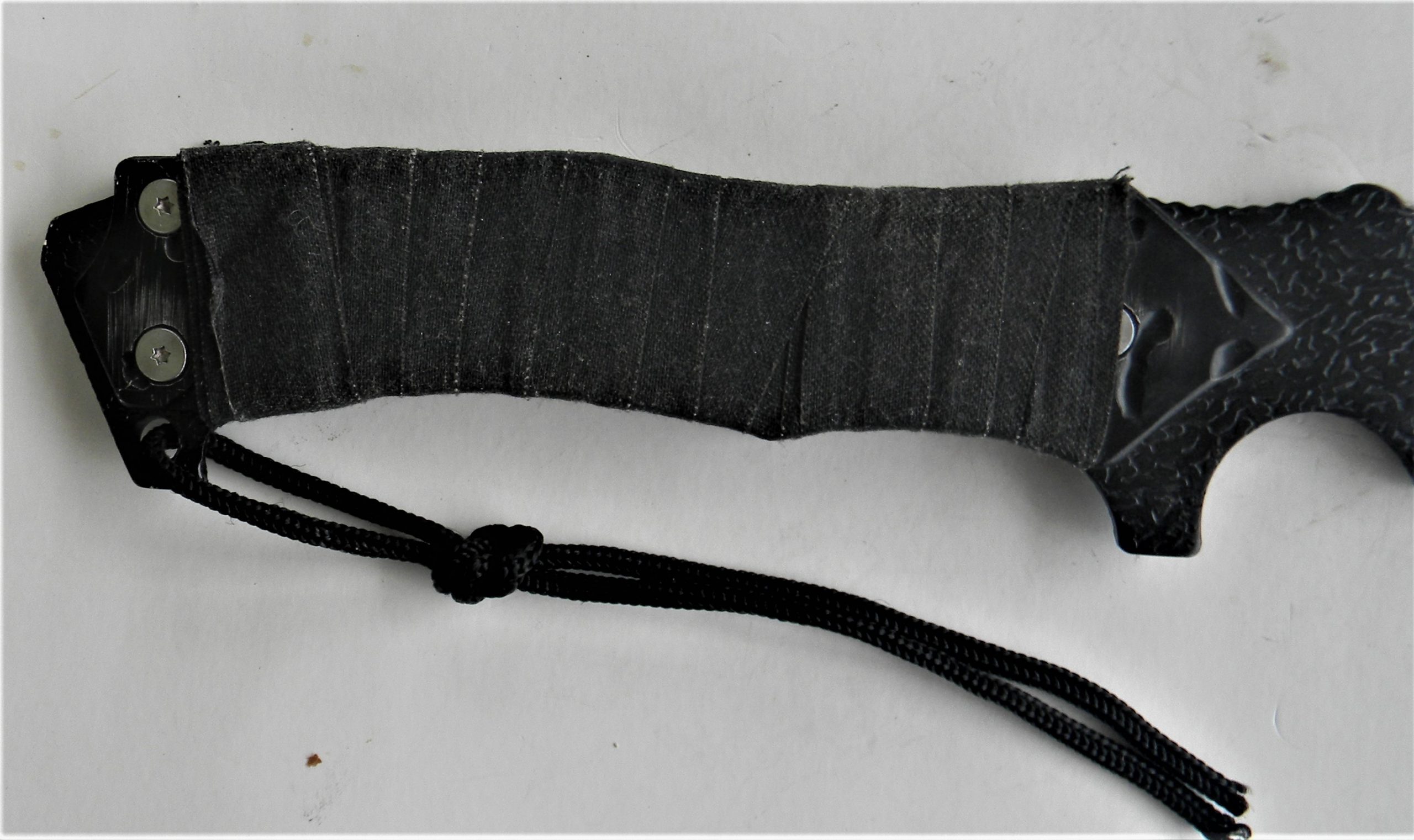
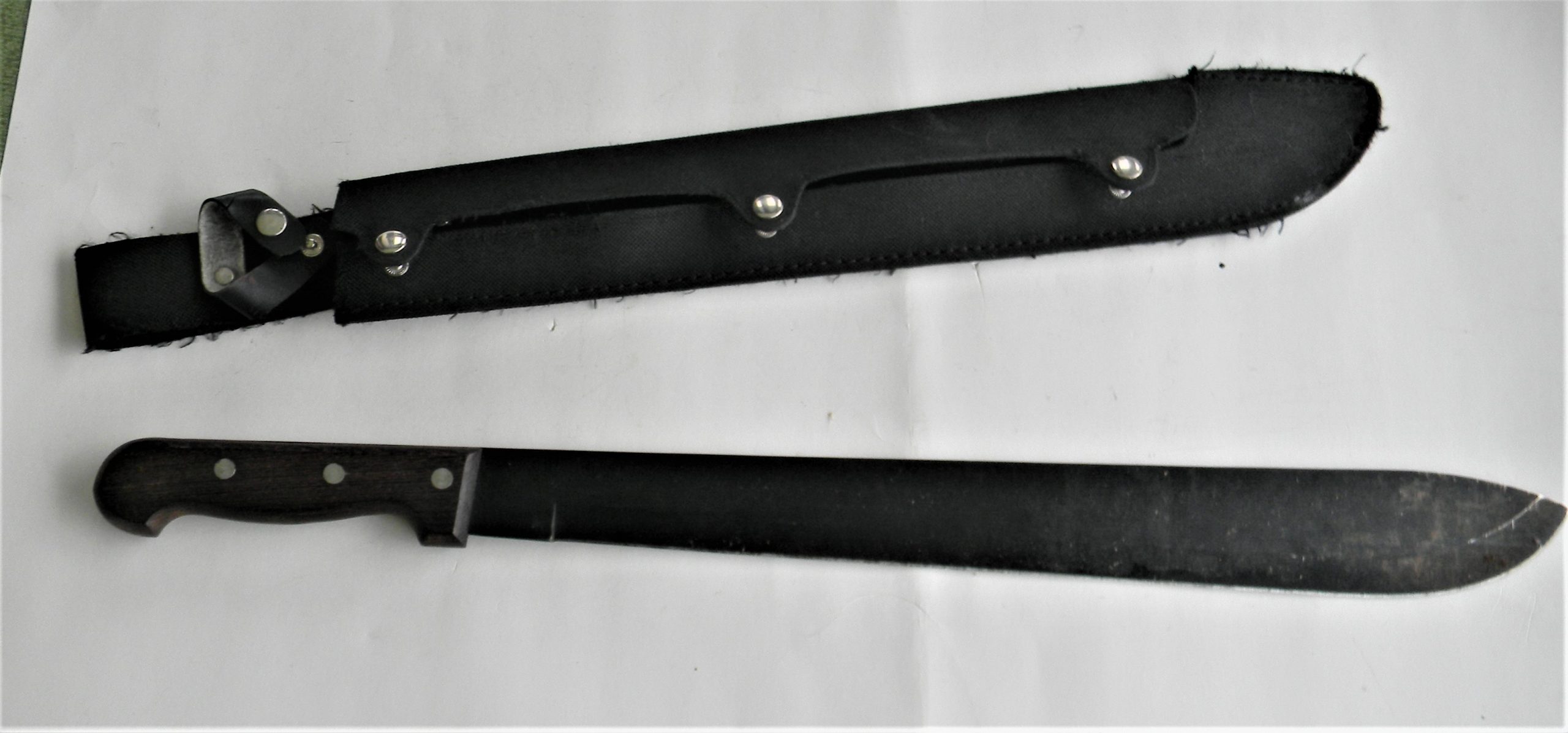

EFFECTIVE HITS =/= “COMBAT ACCURATE”. The Plague of Low Standards
I had an Ellifritzian interesting experience at the local gun range the other day.
I’d gone in just to test fire a couple of guns, and on my way out I saw and overheard an exchange in the next bay.
This was their target at 5 yards.
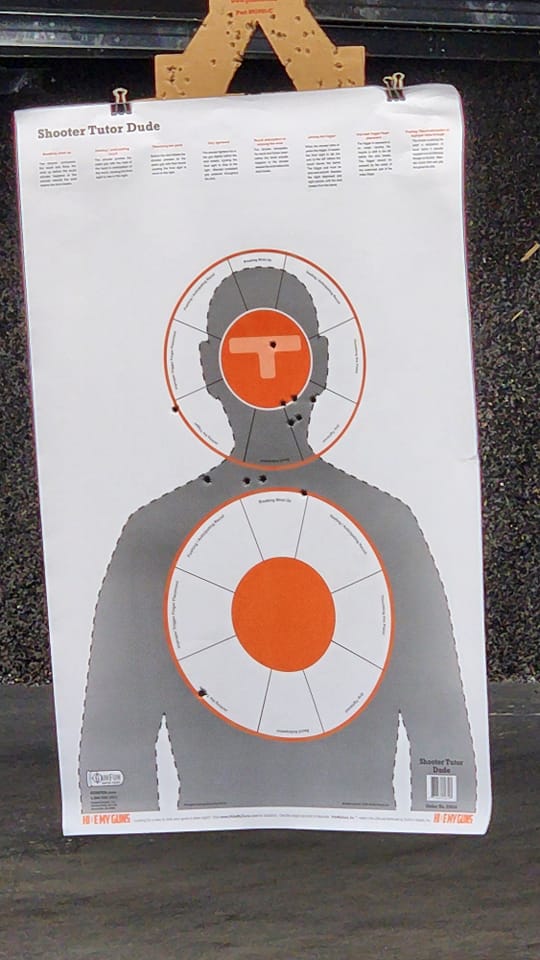
Honestly, I don’t have a problem with the target.
Why? Because from what I overheard, it was very clearly the shooter’s first (or one of their first) times with a handgun. I feel that it’s critical to get new shooters enthusiastic about shooting before we bury them with all the hard work that we insist is necessary to be a competent defensive shooter.
What I had a serious problem with was the feedback that his shooting partner gave:
“Yea, he’s dead! I mean half his face would be missing”

The big issue is that many gun owners/carriers, especially those new to the whole thing, is that most of them approach this with the mentality of “Well I’d sure as hell stop whatever I was doing if I got shot there”.
Problem is I’d be willing to be that 99.9999999999% of them have never been shot before.
When Darryl Bolke talks about his time as a California cop in the bad old days of the 80s, before computers and digital records, many arrestees where cataloged and identified by tattoos and scars, to include bullet wounds.
He observed a staggering number of kids not yet old enough to drink that had been shot more than once.
Think about that for a second. Do you think that a violent criminal actor who has not only been shot before, but survived it to be able to offend again may have a different attitude about it?
This is why we need to normalize anatomically significant hits, and make it part of the conversation outside of the hobbyist training community.
The general population of the gun world at large is plagued with a host of factors that contribute to the unintentional diluting of competency:
- Full B27 Silhouettes
- Carry Permit instructors not emphasizing the importance of continuing education
- The still pervasive gun shop mythologies
We have more ready access to quality information than ever before, as well as current and relevant case studies thanks to folks like Rangemaster and Active Self Protection cataloging the defensive encounters of regular, everyday people.
Unfortunately, these resources are generally used to dunk on the less informed, flexing an intellectual superiority instead of actually trying to educate.
If information is presented with an underlying message of “here’s why you’re stupid and wrong” the likelihood that the other person will be receptive is slim.
So those folks that “know better” need to make sure their delivery is sufficiently palatable as to make the material accessible.

